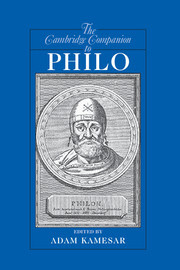4 - Philo’s Thought within the Context of Middle Judaism
from Part 2 - Philo’s Thought
Published online by Cambridge University Press: 28 November 2009
Summary
For centuries, Philo was relegated to the margins of Judaism. This may be due to the Hellenistic spirit that pervades his works and the absence of any reference to him in the rabbinic corpus, especially as contrasted with the warm reception granted to him by the early Christians. In any case, his slight status was largely confirmed by the conception of Second Temple Judaism that was dominant through the first half of the twentieth century. According to that conception, there was a sharp distinction between the Hellenistic Judaism of the Diaspora and the normative Judaism of Palestine, and the former was often characterized as deviant or syncretistic, whereas the latter was thought to be pure and monolithic. Over the past decades this paradigm has gradually crumbled, both because of new discoveries (the Dead Sea Scrolls, papyri, archaeological finds) and because of more in-depth study of the literature of Middle Judaism that was previously available. The current consensus seems to be that only after 70 CE did Judaism acquire a new identity, formulated by the Rabbis in reaction to the destruction of the temple in Jerusalem and characterized by a certain unity in outlook. The system of rabbinic Judaism, although it has real links with the past and did not spring up out of nothing, is based on new ideological constructs and should not be projected back onto the preceding period. Indeed, the Judaism of the Second Temple period, both in Palestine and in the Diaspora, displays considerable diversity both synchronically and diachronically. This diversity reflects different political settings and different social environments, and relates to doctrine and to way of life.
- Type
- Chapter
- Information
- The Cambridge Companion to Philo , pp. 95 - 123Publisher: Cambridge University PressPrint publication year: 2009
- 9
- Cited by



